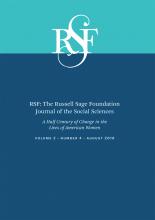Research Article
Open Access
Long Work Hours, Part-Time Work, and Trends in the Gender Gap in Pay, the Motherhood Wage Penalty, and the Fatherhood Wage Premium
Kim A. Weeden, Youngjoo Cha, Mauricio Bucca
RSF: The Russell Sage Foundation Journal of the Social Sciences August 2016, 2 (4) 71-102; DOI: https://doi.org/10.7758/RSF.2016.2.4.03
Kim A. Weeden
aJan Rock Zubrow '77 Professor of Sociology and director of the Center for the Study of Inequality at Cornell University
Youngjoo Cha
bAssociate professor of sociology at Indiana University
Mauricio Bucca
cDoctoral candidate in the Department of Sociology at Cornell University

REFERENCES
- ↵
- Avellar, Sarah, and
- Pamela Smock
- ↵
- Bianchi, Suzanne M.,
- Liana C. Sayer, ,
- Melissa A. Milkie, , and
- John P. Robinson
- ↵
- Budig, Michelle J., and
- Paula England
- ↵Bureau of Labor Statistics (BLS). 2015. “Highlights of Women's Earnings in 2014.” Report no. 1058. Washington: U.S. Department of Labor. Accessed June 27, 2016. http://www.bls.gov/opub/reports/womens-earnings/archive/highlights-of-womens-earnings-in-2014.pdf.
- ↵
- Card, David, and
- John E. DiNardo
- ↵
- Cha, Youngjoo, and
- Kim A. Weeden
- ↵Charles, Maria, and David B. Grusky. 2004. Occupational Ghettos: The Worldwide Segregation of Women and Men. Stanford, Calif.: Stanford University Press.
- ↵
- Clarkberg, Marin, and
- Phyllis Moen
- ↵
- ↵
- ↵
- ↵
- ↵
- England, Paula
- ↵
- Gangl, Markus, and
- Andrea Ziefle
- ↵Gerson, Kathleen. 2009. The Unfinished Revolution: How a New Generation Is Reshaping Family, Work, and Gender in America. Oxford: Oxford University Press.
- ↵
- ↵
- ↵Jacobs, Jerry A., and Kathleen Gerson. 2004. The Time Divide: Work, Family, and Gender Inequality. Cambridge, Mass.: Harvard University Press.
- ↵Juhn, Chinhui, Kevin M. Murphy, and Brooks Pierce. 1991. “Accounting for the Slowdown in Black-White Wage Convergence.” In Workers and Their Wages, edited by Marvin H. Kosters. Washington, D.C.: AEI Press.
- ↵
- Kahn, Joan R.,
- Javier Garcia-Manglano, , and
- Suzanne M. Bianchi
- ↵
- Kalleberg, Arne L
- ↵Kalleberg, Arne L. 2011. Good Jobs, Bad Jobs: The Rise of Polarized and Precarious Employment Systems in the United States, 1970s to 2000s. New York: Russell Sage Foundation.
- ↵
- Killewald, Alexandra
- ↵
- Kuhn, Peter J., and
- Fernando A. Lozano
- ↵
- Lundberg, Shelly J., and
- Eliana Rose
- National Bureau of Economic Research (NBER). 1969–1984. “CPS May Supplement.” Accessed April 11, 2016. http://www.nber.org/data/may.html.
- ↵National Bureau of Economic Research (NBER). 1979–2014. “CPS Merged Outgoing Rotation Groups.” Accessed April 11, 2016. http://www.nber.org/data/morg.html.
- ↵
- ↵
- ↵Ridgeway, Cecilia L. 2011. Framed by Gender: How Gender Inequality Persists in the Modern World. Oxford: Oxford University Press.
- ↵
- Ridgeway, Cecilia L., and
- Shelley J. Correll
- ↵Sharone, Ofer. 2004. “Engineering Overwork: Bell-Curve Management at a High-Tech Firm.” In Fighting for Time: Shifting Boundaries of Work and Social Life, edited by Cynthia Fuchs Epstein and Arne L. Kalleberg. New York: Russell Sage Foundation.
- ↵
- Staff, Jeremy, and
- Jeylan T Mortimer
- ↵Townsend, Nicholas W. 2002. The Package Deal: Marriage, Work, and Fatherhood in Men's Lives. Philadelphia, Pa.: Temple University Press.
- ↵
- Waldfogel, Jane
- ↵Williams, Joan C. 2000. Unbending Gender: Why Family and Work Conflict and What to Do About It. New York: Oxford University Press.
- ↵
- Williams, Joan C, ed
In this issue
Long Work Hours, Part-Time Work, and Trends in the Gender Gap in Pay, the Motherhood Wage Penalty, and the Fatherhood Wage Premium
Kim A. Weeden, Youngjoo Cha, Mauricio Bucca
RSF: The Russell Sage Foundation Journal of the Social Sciences Aug 2016, 2 (4) 71-102; DOI: 10.7758/RSF.2016.2.4.03
Jump to section
Related Articles
- No related articles found.
Cited By...
- No citing articles found.





